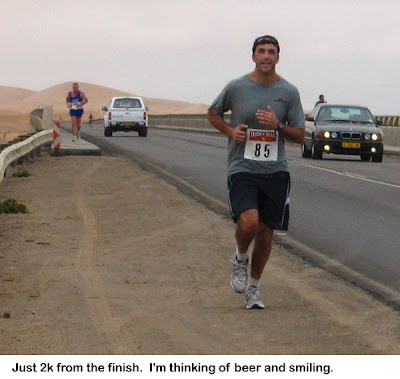The marathon itself was run under ideal conditions. Because Namibia’s coast is cooled by the Benguela current, a cold-water current that comes from Antarctica, it is usually cool and misty. Marathon day was no exception, with overcast skies and temperatures around 50 or 60 farenheit at the start. My friends Chase & Erin drove me to the start—well, almost. Their car died about 3k from the beginning, and a nice race worker took us the rest of the way.
The race began on time – no mean feat in Namibia. At the start, I was running with two 23-year old Peace Corps volunteers, Paul and Adam. Within the first 500 meters, they sprinted ahead of me, fueled by youth and enthusiasm. As I watched them turn a corner away from me in the distance, I thought to myself, “I’ll catch up to you guys.”

The first few k’s wandered around the affluent town of Walvis Bay, which was controlled by Britain and then South Africa. When Namibia gained independence in 1990, South Africa retained control of Walvis for another four years before finally ceding control back to Namibia. Walvis is the only significant port in Namibia, and goods which come into Walvis are shipped to Botswana, Zambia, Congo and Zimbabwe. In fact, after the marathon I met Frans, a trucker who is friends with another volunteer. He drives frozen chickens from Walvis Bay to Lumumbashe in the Congo. Hopefully, I can convince him to take me with him on one of his trips.
After Walvis, the race headed straight up a good coastal road, with large sand dunes on my right and the cold Atlantic Ocean to my left. I stuck pretty steadfastly to my pace of 9 minutes per mile. There were more people than I expected on the running route, because the race was also being run as a 4-person relay for school kids. So, every 6.5 miles, there was a big group of kids waiting for the runners from their school to come in. These kids were amazing: many were running on the tar road barefoot, in flip-flops, or merely with an ace bandage wrapped around the ball of each foot. Over 50 schools from around the country participated, including several teams which were brought by WorldTeach and Peace Corps volunteers. It was a smart, interesting way to get kids hooked on running.

As the miles pounded on, I continued to feel good. Around mile 18, I caught up with Paul, one of the 23-year old Peace Corps guys who had sprinted ahead of me. We chatted for a bit, then I ran on ahead. Seven miles later, I caught up with Adam as well. With just over a mile to go, I sprinted to a 3:55 finish, a personal record, and the satisfaction of running faster than the 20-year olds. Overall, I had what will probably my top-place finish in my life: 36th place! Of course, only 79 people finished, but I still like to think I came in 36th.